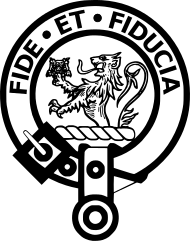Clan Primrose
| Clan Primrose | |
|---|---|
 | |
| Motto | Fide et Fiducia (By Faith And By Trust)[1] |
| Chief | |
 | |
| The Right Honourable Neil | |
| Earl of Rosebery and Midlothian | |
| Seat | Dalmeny House |
Clan Primroseis aLowlandScottish clan.[2]
History[edit]
Origins[edit]
The surname derives from the lands of Primrose in the parish ofDunfermline,Fife.[2]The farmstead stood at the junction of Grange Road and Primrose Lane in what is now a housing estate in the town ofRosyth.The name itself may come from the Pictish words*pren,"tree", and *ros,"moor", or the first element may be*prim,"first".[3]
The earliest recorded ancestor of the Earls of Rosebery isHenry Primrose,born sometime prior to 1490, who lived in the neighbourhood ofCulross Abbey.[4]Henry's son wasGilbert Primrose (surgeon),(c.1535 -18 April 1616), who became Surgeon to KingJames VI of Scotland.
17th century and Civil War[edit]
Gilbert's son wasGilbert Primrose (minister)(1580?–1641), one of the Ministers of the reformed church atBordeaux,and afterwards of theFrench Protestant Church of London.[2]He was appointed Chaplain to King James VI of Scotland (later also King of England and King of Ireland) andCharles I of England.[2]In 1628 he becameDean of Windsor.[2]A grandson of Henry wasJames Primrose(d. 1641) who was Clerk of thePrivy Council of Scotlandand was the second son ofArchibald Primrose of Culross and of Burnbrae, Perthshire(c.1538–?), by Margaret Bleau of Castlehill, Perthshire.[2]By his first wife, Sibylla Miller, James had a son Gilbert, and six daughters, of whom Alison became the second wife of George Heriot [q. v.], jeweller to James VI. By his second wife, Catharine, daughter of Richard Lawson of Boghall, he had six daughters and six sons, including Archibald.[5]
James Primrose died in 1641 and was succeeded in the office of Clerk to the Privy Council of Scotland by his son,Archibald Primrose, Lord Carringtonwho supported the royalistJames Graham, 1st Marquess of Montrose.[2]He joined Montrose after his victory at theBattle of Kilsyth.[2]Archibald Primrose was the king's lieutenant at theBattle of Philiphaughwhere he was captured.[2]He was tried and found guilty of treason, and although his life was spared, he was held in prison until Montrose was ordered by Charles I to disband his army and leave the kingdom.[2]Primrose was later released and knighted by the king.[2]
In 1648 he joined in theEngagers,a scheme to rescue Charles I from the English Parliamentarians, and although the plan was a failure, he survived to joinCharles II of Englandon his march intoEnglandin 1651 and fought at theBattle of Worcester.[2]Charles made him a baronet.[2]The king fled into exile and the Primrose estates were sequestrated.[2]
The Primrose estates were restored after theRestoration of 1660,and Primrose was appointed a judge of the Supreme Court and Lord Clerk Register of Scotland.[2]He took the title, "Lord Carrington" and was opposed to the policies of theDuke of Lauderdale.[2]Primrose resigned his offices, but from 1676 to 1678 he was lord Justice General.[2]Later he acquired the barony of Barnbougle and Dalmeny which remains the seat of the family to this day.[2]
18th century[edit]
The Lord Justice General was succeeded by his son, Sir William Primrose, and his son, Sir James Primrose of Carrington, was elected Commissioner of Parliament forEdinburghin 1703.[2]In November of the same year he was elevated to the peerage as Viscount Primrose.[2]
The second Viscount died unmarried in 1706, and his brother, Hugh, the third Viscount, left no issue.[2]Archibald Primrose, (b.1664) was the only son by the second marriage of Sir Archibald, the Lord Justice General, who left to him the estate of Dalmeny.[2]He was appointed a Gentleman of the Bedchamber after the accession ofWilliam of Orange.[2]From 1695 to 1700 he was Commissioner of Parliament for Edinburgh.[2]He was also created Viscount of Rosebery, Lord Primrose and Dalmeny.[2]On the accession ofAnne, Queen of Great Britainhe was advanced to the rank of earl.[2]
He was a Privy Councillor in 1707 and was appointed as a commissioner for theTreaty of Union.[2]He was one of the sixteen peers elected to represent Scotland in the House of Lords after the union.[2]
Sir Archibald Primrose was of Dunipace was executed in 1746 for being a Jacobite.[2]
The third Earl was a representative peer, and he was made aKnight of the Thistlein 1771.[2]
19th century[edit]
Archibald John, as fourth Earl of Rosebery was a Member of Parliament for Hellston and later Carlisle and was created a baron of theUnited Kingdomwith the title of 'Lord Rosebery' in 1828.[2]In 1840, like his father, he was made a Knight of the Thistle.[2]Three years later he was appointed Lord Lieutenant of Linlithgowshire.[2]
Castle[edit]

The seat of the Chief of Clan Primrose is atDalmeny HouseinWest Lothianon theFirth of ForthinScotland.
Clan Chief[edit]
The current Chief of Clan Primrose isNeil Primrose, 7th Earl of Rosebery
See also[edit]
References[edit]
- ^Clan Primrose Profilescotclans. Retrieved 14 December 2013.
- ^abcdefghijklmnopqrstuvwxyzaaabacadaeafagWay, George and Squire, Romily.Collins Scottish Clan & Family Encyclopedia.(Foreword by The Rt Hon. The Earl of Elgin KT, Convenor, TheStanding Council of Scottish Chiefs). Published in 1994. Pages 296 - 297.
- ^"Fife Place-Name Data".Glasgow University.
- ^Paul, Sir James Balfour.The Scots Peerage,Volume VII. Published in 1909.
- ^wikisource
